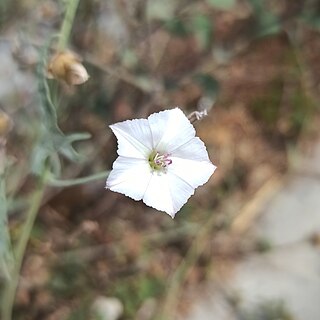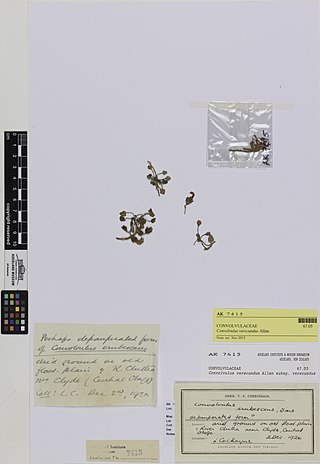
Convolvulaceae, commonly called the bindweeds or morning glories, is a family of about 60 genera and more than 1,650 species. These species are primarily herbaceous vines, but also include trees, shrubs and herbs. The tubers of several species are edible, the best known of which is the sweet potato.

Convolvulus is a genus of about 200 to 250 species of flowering plants in the bindweed family Convolvulaceae, with a cosmopolitan distribution. Common names include bindweed and morning glory; both names shared with other closely related genera.

Fallopia is a genus of about 12 species of flowering plants in the buckwheat family, often included in a wider treatment of the related genus Polygonum in the past, and previously including Reynoutria. The genus is native to temperate and subtropical regions of the Northern Hemisphere, but species have been introduced elsewhere. The genus includes species forming vines and shrubs.

Argophyllaceae is a family of shrubs or small trees belonging to the order Asterales. The family includes c. 24 species in two genera, Argophyllum and Corokia. Members of the family are native to eastern Australia, New Zealand, Lord Howe Island, New Caledonia, and Rapa Iti.

Calystegia sepium is a species of flowering plant in the family Convolvulaceae. It has a subcosmopolitan distribution throughout temperate regions of the North and South hemispheres.

Erythroxylaceae is a family of flowering trees and shrubs consisting of 4 genera and 271 species. The four genera are AneulophusBenth., ErythroxylumP.Browne, NectaropetalumEngl., and PinacopodiumExell & Mendonça. The best-known species are the coca plants, including the species Erythroxylum coca, the source of the substance coca.

Convolvulus arvensis, the field bindweed, is a species of bindweed that is rhizomatous and is in the morning glory family (Convolvulaceae), native to Europe and Asia. It is a climbing or creeping herbaceous perennial plant with stems growing to 0.5–2 metres (1.6–6.6 ft) in length, usually found at ground level, with small, white and pink flowers.

The genus of the myrrhs, Commiphora, is the most species-rich genus of flowering plants in the frankincense and myrrh family, Burseraceae. The genus contains approximately 190 species of shrubs and trees, which are distributed throughout the (sub-) tropical regions of Africa, the western Indian Ocean islands, the Arabian Peninsula, India, and South America. The genus is drought-tolerant and common throughout the xerophytic scrub, seasonally dry tropical forests, and woodlands of these regions.
Mesogyne is a genus of plants in the family Moraceae. The genus is found in east Africa.

Convolvulus clementii, commonly known as desert bindweed, is a trailing perennial plant species, native to inland Australia. Mostly found on flat areas, like dune swales and claypans that are subject to seasonal inundation, in areas of open grassy woodland.
Convolvulus oxyphyllus is a species of flowering plant in the family Convolvulaceae, native to Iraq, Iran, Kuwait and Saudi Arabia. It was first described by Pierre Edmond Boissier in 1846.

Convolvulus equitans, commonly known as Texas bindweed, is a species of morning glory. It is native to the central and western United States and Mexico.
Convolvulus erinaceus is a species of plant in the family Convolvulaceae. It is native to the Central Asia and the Near East.

Convolvulus farinosus is a species of plant in the family Convolvulaceae. It is native to sub-Saharan Africa.
Convolvulus fernandesii is a species of plant in the family Convolvulaceae. It is endemic to the Arrábida Natural Park, Portugal.

Convolvulus verecundus, commonly known as trailing bindweed or tussock bindweed, is a species of low-growing flowering plant in the family Convolvulaceae. Endemic to New Zealand, it was formally described as a new species by botanist Harry Allan in his 1961 work Flora of New Zealand. The type was collected near Lake Tekapo in the gorge of the Cass River, at an elevation of 850 m (2,790 ft).

Convolvulus oleifolius is a species of plant in the family Convolvulaceae.

Convolvulus simulans is a species of annual plant in the morning glory family known as the small-flowered morning-glory and small-flowered bindweed. It is an inconspicuous vining plant that is characterized by tiny pale pink or pale blue bell-shaped flowers. It is typically restricted to clay and serpentine substrates in annual grassland, coastal sage scrub and chaparral habitats. This species is native to Arizona, California, and Baja California. Some taxonomies place this species under Convolvulus equitans.













